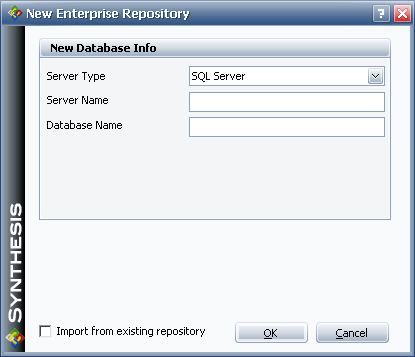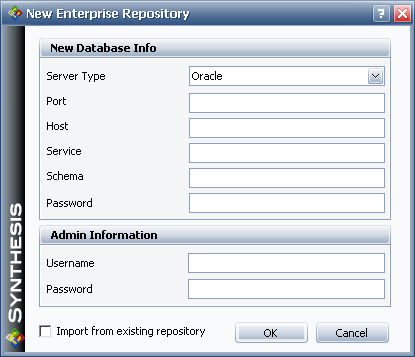![]()
![]()
| Related Topics: | ||
|
Connecting to an Existing Enterprise Database |
||
If your organization already has established a database server with Oracle or Microsoft SQL Server and you have the permissions necessary to create a new database on the server, you can choose File > Manage Repository > Repository Creation to open a wizard that will guide you through the steps to create a new database.
![]()
The first step in the wizard allows you to specify where you want to create the new database. If you choose SQL Server from the Server Type drop-down list, the window will look like the one shown next.

In the Server Name field, type the name of the Microsoft SQL Server implementation where the new database will be created.
Note: If you are creating a local SQL Server Express repository (i.e., if SQL Server is implemented on your computer rather than on a database server), the server name is usually your login for that computer followed by \SQLEXPRESS (i.e., UserName\SQLEXPRESS).
In the Database Name field, type the name of the new enterprise database that will be created.
If you choose Oracle from the Server Type drop-down list, the window will look like the one shown next.

You will need the following information:
Port, Host and Service identifiers for the Oracle server where the new database will be created.
Schema of the new Enterprise database.
Password for the new enterprise database schema.
The administrative username and password for the Oracle server (entered in the Admin Information area).
For either server type, select the Import from existing repository check box if you want to import entire projects and other data from an existing repository. See Importing Data from an Existing Repository.
Click OK to create the database. The database will not open automatically; you must connect to it. See Connecting to an Existing Enterprise Database.
IMPORTANT for SQL Server Databases: To create a functioning user account in a SQL Server database, the username must be associated with a SQL Server Login, which allows SQL Server to recognize the username via Windows Authentication. There are three ways to ensure that a user account created via a Synthesis-enabled application will be associated with a SQL Server Login. If you have not employed one of these three methods, then the user account will not be able to log in to the SQL Server database. For more detailed instructions, See SQL Server Logins or Using Windows Impersonation.
When you are connected to an enterprise database, a connection speed indicator will be displayed in the MDI status bar.
 < 30 ms: Good (acceptable performance)
< 30 ms: Good (acceptable performance)
 30 - 70 ms: OK (may exhibit some delays in operations, opening/closing windows, etc.)
30 - 70 ms: OK (may exhibit some delays in operations, opening/closing windows, etc.)
 70 - 110 ms: Slow (will exhibit some delays in operations, opening/closing windows, etc.)
70 - 110 ms: Slow (will exhibit some delays in operations, opening/closing windows, etc.)
 110 - 150 ms: Very slow (will exhibit significant delays in operations, opening/closing windows, etc.)
110 - 150 ms: Very slow (will exhibit significant delays in operations, opening/closing windows, etc.)
 > 150 ms: Extremely slow (will result in unacceptable performance and usability)
> 150 ms: Extremely slow (will result in unacceptable performance and usability)
© 1992-2013. ReliaSoft Corporation. ALL RIGHTS RESERVED.